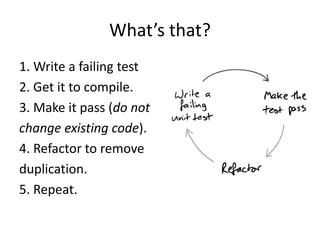Tdd
- 1. Test Driven Development ŌĆó WhatŌĆÖs that? ŌĆó The goodŌĆ” ŌĆó The badŌĆ” ŌĆó And the uglyŌĆ” ŌĆó How do we begin? ŌĆó How do we make it sustainable? ŌĆó Food for thought
- 2. WhatŌĆÖs that? 1. Write a failing test 2. Get it to compile. 3. Make it pass (do not change existing code). 4. Refactor to remove duplication. 5. Repeat.
- 4. The goodŌĆ” ŌĆó Edit and pray vs. Cover and Modify ŌĆó Feedback, feedback, feedback! ŌĆó Get a living Documentation ŌĆó You have nothing to lose but your bugs! ŌĆó Helps you design on the go ŌĆó Makes ownership transfer much easier ŌĆó Gives you more confidence in making changes to the code
- 5. The goodŌĆ” ŌĆó ItŌĆÖs highly likely that the code you write will: ŌĆō Do what itŌĆÖs meant to do! ŌĆō Keep methods short & simple ŌĆō Keep dependencies as weak as possible ŌĆō Go 100% for Single Responsibility ŌĆō Not have duplicates ŌĆō Be protected from invalid input ŌĆō Have many other qualities that make it awesome ’üŖ
- 6. The badŌĆ” ŌĆó You have to break some habits ŌĆó YouŌĆÖll have some development time overhead ŌĆó You need to keep the test code as clean as the production code ŌĆó You still need the high level designs ŌĆó You still need more testing
- 7. And the uglyŌĆ” ŌĆó TDD is only good when itŌĆÖs done properly ŌĆó Coding AinŌĆÖt Done ŌĆśTil All the Tests Run*ŌĆ” AND pass!
- 8. Is it worth it?! ŌĆó 100k lines of code => 15 issues 6 months after the release ŌĆó ThereŌĆÖs no bug-free product, but there are collateral issues safe nets.
- 9. How do we begin? 1. Understand the problem 2. High-level architecture 3. Ensure automation for: ŌĆō Writing tests ŌĆō Building ŌĆō Running Tests 4. Write a failing acceptance test = walking skeleton ’üŖ 5. Write a failing unit test 6. Make the unit test pass 7. Refactor 8. Repeat Steps 5-7 until you make the acceptance test pass 9. Repeat Steps 4-8 until all the acceptance tests pass.
- 10. Automation tools ŌĆó Tests Explorer (VS2012) ŌĆó MSUnit ŌĆō As simple as ŌĆ£Create New ProjectŌĆØ ŌĆō Generate methods from Unit Tests (VS2012) ŌĆó Microsoft Fakes ŌĆó Code Coverage Tools ŌĆó CM Integration
- 11. How do we make it sustainable? ŌĆó Always start by writing a test for the easiest success case ŌĆó ŌĆ£ListenŌĆØ to the tests to get rid of uncertainty in the high level design ŌĆó Always make the tests send correct messages when running ŌĆó Minimize the implementation overhead: ŌĆō Only write tests that you would like to read ŌĆō focused, well named, nicely written ŌĆō Updating the code => updating test code
- 12. Three laws of TDD ŌĆó First Law You may not write production code until you have written a failing test. ŌĆó Second Law You may not write more of a test than is sufficient to fail, and not compiling is failing. ŌĆó Third Law You may not write more production code than is sufficient to pass the currently failing test.
- 13. Food for thoughtŌĆ” ŌĆó http://msdn.microsoft.com/en- us/library/hh212233.aspx ŌĆó Clean Code A Handbook of Agile Software Crafts [Robert Martin] ŌĆó Working effectively with legacy code [Martin Fowler] ŌĆó Growing object-oriented software guided by tests [Steve Freeman, Nat Pryce]













![Food for thoughtŌĆ”
ŌĆó http://msdn.microsoft.com/en-
us/library/hh212233.aspx
ŌĆó Clean Code A Handbook of Agile Software
Crafts [Robert Martin]
ŌĆó Working effectively with legacy code [Martin
Fowler]
ŌĆó Growing object-oriented software guided by
tests [Steve Freeman, Nat Pryce]](https://image.slidesharecdn.com/tdd-121205153618-phpapp01/85/Tdd-13-320.jpg)